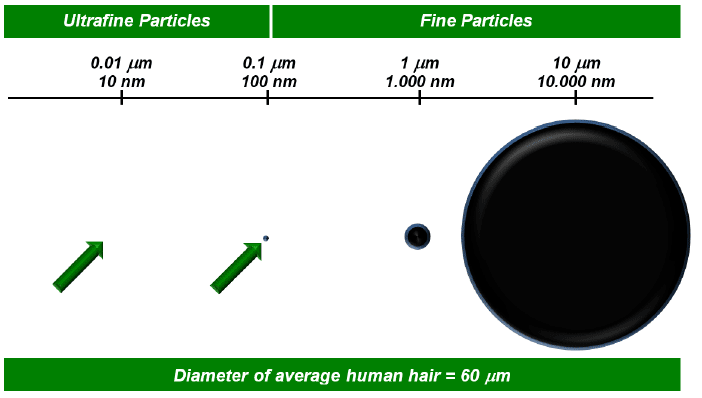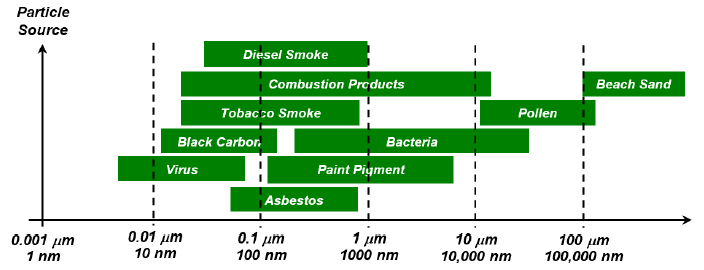Air quality study: assessing variations in roadside air quality with sampling height
A mobile air quality monitoring study commissioned to assess variations in roadside air quality.
2 Pollutants Investigated
There are many different air pollutants within a city with numerous sources. For 2012 the Scotland Air Quality Pollutant Inventory for emission of air quality pollutants (Defra et al., 2014) noted the sources and contribution of many of the major air pollutants within Scotland. It can be clearly seen in Table 2.1 that transport is responsible for a major proportion of the pollutants of interest, with industrial & residential combustion and energy production also contributing significantly. As the Glasgow study has taken place within an urban environment in close proximity to roads and focuses on the measurement of particulate matter, black carbon and oxides of nitrogen, it is likely that the majority of pollutant concentrations observed originate from road traffic sources, with the other sources being of less significance.
Table 2.1 Scotland Air Quality Pollutant Inventories 2012: Source Emission Contributions (Defra et al. 2014)
| Sector |
NH 3 |
CO |
NOx |
NMVOC |
PM 10 |
SO 2 |
Pb |
NH 3 |
|---|---|---|---|---|---|---|---|---|
| Commercial, domestic and agricultural combustion |
1.05% |
38.98% |
11.78% |
3.81% |
36.94% |
13.63% |
24.63% |
1.05% |
| Transport Sources |
2.09% |
30.11% |
37.79% |
2.53% |
19.59% |
2.18% |
5.42% |
2.09% |
| Energy Industries |
0.00% |
5.72% |
33.25% |
0.00% |
9.16% |
74.74% |
33.35% |
0.00% |
| Industrial Processes |
0.22% |
2.81% |
0.02% |
44.42% |
9.74% |
1.16% |
9.34% |
0.22% |
| Industrial Combustion |
0.00% |
20.23% |
14.51% |
1.14% |
6.90% |
7.35% |
24.14% |
0.00% |
| Agriculture |
86.51% |
0.00% |
0.00% |
7.11% |
10.77% |
0.00% |
0.00% |
86.51% |
| Other |
5.51% |
1.75% |
2.65% |
0.49% |
3.96% |
0.74% |
3.12% |
5.51% |
| Fugitive |
0.00% |
0.42% |
0.00% |
16.73% |
0.97% |
0.20% |
0.00% |
0.00% |
| Solvent Processes |
0.00% |
0.00% |
0.00% |
19.82% |
1.96% |
0.00% |
0.00% |
0.00% |
| Waste |
4.62% |
0.00% |
0.00% |
3.96% |
0.00% |
0.00% |
0.00% |
4.62% |
Emission of many of the pollutants listed in Table 2.1 have been substantially reduced (by more than 50%) in recent years when compared with figures from 1990 (Table 2.2). Many of these reported reductions can be accounted for by improved technologies, for example improved vehicle engine efficiency and changes in exhaust processing, or due to a change in combustion sources, for example the use of renewable for energy production.
Table 2.2 Pollutant emissions and reduction in Scotland (adapted from Defra et al., 2014)
| Pollutant |
Emissions in 2012 (kt) |
Reduction since 1990 (%) |
|---|---|---|
| Carbon Monoxide (CO) |
169.0 |
79 |
| Nitrogen Oxides (NO x) |
98.1 |
65 |
| PM 10 |
11.8 |
59 |
| Sulphur Dioxide (SO 2) |
64.9 |
78 |
A more detailed description of the pollutants investigated in this study together with their reported effects on human health and the environment is provided below.
2.1 Particulate Matter
Particulate matter (PM) or particulates are microscopic solid or liquid matter suspended in the air we breathe. It is well established that increased PM concentrations in ambient air have a direct impact on the general public's health, with worldwide epidemiological studies establishing a connection between PM exposure and adverse health effects (Pope III and Dockery, 2006, Nawrot et al., 2007). More recently the World Health Organisation published a survey linking poor air quality to stroke and heart disease, as well as respiratory diseases, with 7 million estimated deaths worldwide attributed to air pollution in 2012, with particulates being the chief cause ( WHO, 2014). The European Environment Agency recently stated that "of all air pollutants, PM is the most harmful to health in Europe" ( EEA, 2014). As such, PM is regarded as a non-threshold pollutant and so any reduction in PM concentrations in ambient air is likely to have a beneficial effect on health.
Particulate matter encompasses a wide range of particle sizes and can be principally split into two categories; ultrafine particles with a diameter of less than 0.1 m (or 100 nm); and fine particles with a diameter of greater than 100 nm. Figure 2.1 illustrates the size difference between particles of 4 diameters; 10 m, 1 m, 0.1 m and 0.01 m. To provide additional context, Figure 2.2 shows examples of particulate matter sources in relation to particle diameter.
Figure 2.1 Pollutant emissions and reduction in Scotland (adapted from (MacCarthy et al., 2012)

Figure 2.2 Particulate Matter (adapted from (Hinds, 1999)

For the purposed of Local Air Quality Management, local authorities in Scotland are currently only required to measure the mass of particulate matter with an aerodynamic mean diameter of 10 m (PM 10). However, national measurements of PM 2.5 concentrations are made with monitoring sites within the national Automatic Urban and Rural Network ( AURN). Fine Particles are composed of a wide range of materials arising from a variety of sources including:
- Combustion sources: The sources within developed countries are primarily from transport, mainly diesel vehicles, whereas biomass within developing countries is probably more important (Dons et al., 2012).
- Secondary particles, comprising of mainly sulphates and nitrates formed by chemical reactions in the atmosphere, and often transported from far across Europe.
- Coarse particles, suspended soils and dusts (e.g. from the Sahara), sea salt, biological particles and particles from construction work.
Particles are measured in a number of different size fractions according to their mean aerodynamic diameter. Most monitoring is currently focussed on PM 10, which has a mean aerodynamic diameter of 10 µm. However, the finer fractions such as PM 2.5 and PM 1 are becoming of increasing interest in terms of health effects. These fine particles can be carried deeper into the lungs where they can cause inflammation and a worsening of the condition of people with heart and lung diseases. In addition, they may carry surface-absorbed carcinogenic compounds into the lungs. Dons et al. (2012) noted that the health effects of PM 2.5 were well documented, and that black carbon was one of the most harmful constituents; with cardiovascular, respiratory disease and even mortality being the effects of exposure.
Most commonly, Particulate Matter is measured using mass-based techniques, but as a particle gets smaller they tend to be more numerous, hence measurement of ultrafine particles is carried out using a particle counting technique involving light scattering or absorption.
2.2 Other Pollutants Investigated in the Study
In addition to particulate matter, which was the focus pollutant of the study, the study took the opportunity to monitor and compare concentrations of other key pollutants that are of interest in terms of their potential impact on human health and the wider environment. A brief summary of these pollutants is provided in Table 2.3.
Table 2.3 Other Pollutants Monitored
| Pollutant |
Summary |
|---|---|
| Black Carbon ( BC) |
Black carbon ( BC) is a measure of airborne 'soot-like' carbon. It is typically formed through the incomplete combustion of fossil fuels, biofuel, and biomass, and is emitted in both man-made and naturally occurring soot. BC is a useful indicator of traffic pollution and is relatively simple and inexpensive to measure. It is linked to adverse health effects but also affects the planet by absorbing heat in the atmosphere and by reducing the earth's ability to reflect sunlight when deposited on snow and ice. |
| Ultrafine Particles ( UFPs) |
Ultrafine particles ( UFPs) make up approximately 80% of the total particle numbers in air, even though the majority of the particulate mass is due to larger fine particles. Thus, this means although by mass (concentration) there are less finer or ultrafine particulates, these particles are normally significantly more numerous (Hinds, 1999); and as even small numbers of particles may be detrimental to health. Thus, the role and measurement of number concentration could be equally important to PM mass in the local air quality management context. |
| Nitrogen dioxide (NO 2) |
Nitrogen dioxide is a key air pollutant of concern within the UK Local Air Quality Management regime. It can irritate the lungs and lower resistance to respiratory infections such as influenza (Barnett et al., 2005, Bernstein et al., 2004), with increased asthma and respiratory admissions typical with higher NO 2 concentrations. |
| Carbon monoxide (CO) |
Carbon Monoxide (CO) is a colourless, odourless poisonous gas produced by incomplete, or inefficient, combustion of fuel. It is predominantly produced by road transport, in particular petrol-engine vehicles. The gas prevents the normal transport of oxygen by the blood and can lead to acute health effects, such as a significant reduction in the supply of oxygen to the heart. |
| Carbon dioxide (CO 2) |
Carbon dioxide is produced when a material, or fuel, containing carbon is burned. Globally, much of the carbon dioxide in the atmosphere comes from natural sources, but increasingly humans are adding carbon dioxide to the atmosphere through the combustion of fossil fuels for energy. CO 2 displaces oxygen in the air and in confined spaces can lead to shortness of breath and headaches. CO 2 as an important greenhouse gas contributes to climate change. |
| Sulphur dioxide (SO 2) |
Anthropogenic sulphur dioxide (SO 2) is produced when a material, or fuel, containing sulphur is burned. Concentrations of SO 2 measured in Scotland's air are primarily associated with emissions from power stations burning fossil fuels, such as heavy oils or coal. Sulphur dioxide is both damaging to health, the environment and to where we live, as it forms a corrosive acid when combined with water. Acid rain from the formation of sulphuric acid has been implicated in the damage and destruction of vegetation and in the degradation of soils, building materials and watercourses ( US EPA, 2006). |
| Benzene (C 6H 6) |
Benzene (C 6H 6) is an aromatic organic compound which is a minor constituent of petrol (about 2% by volume). The main sources of benzene in the atmosphere are normally from the distribution and combustion of petrol, and to a limited extent industrial usage and processes. Benzene is a known human carcinogen and is associated with a large number of health effects include cancer, damage to the central nervous system, liver, kidneys, reproductive disorders and birth defects birth defects ( US EPA, 2003). |
Contact
There is a problem
Thanks for your feedback